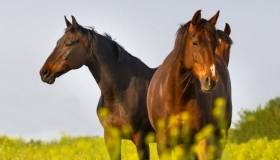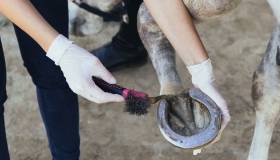
Updated April 4, 2024 – Hip dysplasia is a common developmental problem in large and giant breed dogs and, by some estimates, is the most common inherited disease seen in dogs. Hip dysplasia typically leads to osteoarthritis of the hip joints, a crippling and painful disease that can significantly impact a dog’s quality of life. In addition, the disease can be a financial and emotional burden for dog owners.
The disease has a global distribution and affects male and female dogs equally. Any large or giant breed dog, including large-sized mixed breed dogs, can develop the disease. Although reported in smaller breed dogs, it is much less common.
Breeds most frequently affected include:
- German shepherd
- Rottweiler
- Golden retriever
- Saint Bernard
- Labrador retriever
- Newfoundland
Hip dysplasia was first described in 1935 and has been the subject of intense investigation for decades. There have been dozens of studies looking at everything from the genetics underpinning the condition to treatments to preventive measures. The quantity of data on this problem is mind-boggling. In this article, we’ll discuss the basics of hip dysplasia and explore new information on this joint but complex disease.
A Developmental Disease
Although hip dysplasia is an essential cause of osteoarthritis in older dogs, the disease begins in puppyhood. The underlying abnormality is the hip joint's laxity, resulting in instability. This instability, in turn, leads to progressive degeneration of the joint and clinical signs of osteoarthritis.
Puppies with a genetic predisposition are born with normal hips, but changes begin within a few weeks of birth. Sometimes, lameness and gait abnormalities start at three months, while other dogs may not exhibit signs for years.
Clinical Signs of Hip Dysplasia
The American College of Veterinary Surgeons divides hip dysplasia into two groups based on age. Group one consists of younger dogs that don’t have arthritis, but because their hips are malformed, they can show clinical signs due to this laxity. Group two consists of mature dogs with hip osteoarthritis secondary to hip dysplasia.
Signs of hip dysplasia in either group can include:
- Bunny-hopping gait
- Rear-leg lameness (in one or both limbs)
- Difficulty rising
- Clicking sound from hips when moving or rising
- Weight shifting to front limbs
- Inability to exercise for long periods
- History of progressive rear limb lameness
- Lameness after exercise
- Loss of muscle mass in one or both rear legs
- Difficulty jumping or climbing stairs
It’s not unusual for young dogs to exhibit signs of hip dysplasia and then seem to get better. Improvement can happen because the body produces fibrous tissue to stabilize the loose joint(s). About 30% of dogs will need additional treatment later in life, but many can do well for long periods without treatment.
Genetics Play a Significant Role in Hip Dysplasia
Many years ago, researchers recognized that dogs with hip dysplasia often passed on the disease to their puppies. In addition, the fact that the disease had a strong breed disposition also suggested it was inherited. Breed groups have been instrumental in identifying individuals with poor hips and removing them from the breeding pool.
Advances in molecular biology have allowed scientists to delve more deeply into the genetics of dogs with hip dysplasia. Researchers worldwide are conducting dozens of studies looking to pinpoint a specific gene, or genes, responsible for the disease. The goal is to identify a genetic marker for the disease that researchers could use to screen dogs.
Recent work on German shepherd dogs by a team at the University of Helsinki suggests that multiple locations on different chromosomes might be involved in hip dysplasia. Interestingly, the group reported that osteoarthritis mapped to chromosome 1, but joint incongruity mapped to chromosomes 9 and 28. The team plans on looking at these regions more closely to find genetic variations that could eventually inform the development of a genetic test.
Other Factors
Although researchers have long recognized that hip dysplasia has a strong genetic component, genetics alone do not explain why some dogs develop hip dysplasia while others with a genetic predisposition do not.
Excessive caloric intake causes rapid growth, weight gain, and heavy exercise, risk factors for hip dysplasia in a puppy with a genetic predisposition. These conditions are associated with bone growth that outpaces the development of the soft tissue structures important for joint stabilization, leading to joint laxity. As described earlier, joint laxity starts the cascade of events that results in osteoarthritis.
In some dogs, controlling these external factors can influence whether hip dysplasia develops or not, or it can modulate the severity of signs.
Diagnosis – Clinical Signs and X-ray Evidence
Physical examination findings coupled with history can raise suspicion of hip dysplasia. X-rays are essential to the work-up in a dog of any age with hip joint pain. Essential X-rays can be highly informative, particularly in an older dog.
Particular types of X-rays can screen dogs for hip dysplasia. Many breed organizations worldwide have embraced these special tests to improve hip conformation and keep dogs with mediocre and poor hip quality out of the breeding pool.
Two of the most common advanced screening tests in the United States are the Orthopedic Foundation for Animals protocol and the PennHIP protocol. Veterinarians use these techniques to screen young dogs for evidence of hip dysplasia. Both were developed to assess hip conformation and to predict the likelihood of degenerative joint disease development later in life.
Key differences between these two methods include:
- Age of screening – PennHIP can be done on dogs as young as 4 months old, whereas OFA screening requires dogs to be at least 2 years old.
- Most dogs do not need sedation for OFA, but PennHIP requires sedation.
- Any veterinarian can take the X-rays required for OFA certifications, but special training is necessary for PennHIP.
- Although helpful, OFA certification doesn’t guarantee that a dog will not develop osteoarthritis later in life or that the offspring will not. PennHIP is more accurate in predicting whether or not osteoarthritis will develop later in life.
- Costs – At most hospitals that perform both procedures, PennHIP evaluation is more expensive than OFA.
OFA certification remains one of the most common and accepted assessments of hip dysplasia in the United States.
Regarding optimal testing procedures, each test has pros and cons, and it’s essential to work with your veterinarian to determine which test (if any) is best for your pet. If you're considering getting a large or giant breed puppy, inquire with your breeder whether they performed any hip evaluations on the sire and dam.
Europe and the United Kingdom use other testing schemes. They may impact breeders of dogs in the United States or owners if they’re importing a dog from abroad. It’s essential for pet parents considering obtaining a dog from outside the United States to familiarize themselves with these other types of testing.
The critical point is that all these are predictive tests, and other factors can influence whether or not a dog ever shows signs of disease.
Treatment of Hip Dysplasia
Although hip dysplasia is a progressive condition, many treatments are available to help dogs of all ages.
Pain management: Pain management is a critical component of treatment for hip dysplasia at any age. Nonsteroidal anti-inflammatory drugs (NSAIDs) remain the cornerstone of medical therapy. Several different types of NSAIDS are available for veterinary patients, and many studies have demonstrated their efficacy in treating pain associated with osteoarthritis.
Analgesics often are added to NSAID therapy to provide additional relief. Many of these drugs are familiar to most dog owners and are used to provide analgesia to people with osteoarthritis. Gabapentin, tramadol and codeine are common drugs that fall into this category.
As mentioned earlier, some young dogs with hip dysplasia will stabilize as they mature. Conservative management consisting of limited exercise and pain management, coupled with physical therapy, can help pups through this period until stabilization. If successful, only 30% of young dogs treated this way will need advanced therapies later in life.
Never give your dog any human nonsteroidal anti-inflammatory drugs. Many of these drugs are toxic to dogs!
Sometimes, veterinarians indicate surgery to help manage pain and improve hip mobility and function. The type of surgical procedure recommended depends on a dog’s age and severity of signs.
Surgical procedures available for dogs with hip dysplasia include:
- Triple pelvic osteotomy – used in young dogs that have failed conservative therapy, this surgery requires a skilled surgeon. This surgery has a high success rate, with 80-90% of cases regaining good or better function within 3 months.
- Surgeons use total hip replacement in dogs over 12 months, young and older. Like the procedure in people, degenerated joint structures are removed and replaced with synthetic components. 90% and 95% of dogs with total hip replacement have excellent post-surgery function.
- Surgeons perform excision arthroplasty/femoral head ostectomy as a salvage procedure to alleviate painful rubbing within the hip joint by removing the top of the femur.
- The procedure is used only as a last resort when other treatments fail, and other surgical procedures are not an option.
Other treatment strategies include:
- Maintaining a healthy, lean body weight to relieve joint stress is a must for any dog with hip dysplasia
- Studies have shown that physical therapy improves muscle strength and quality of life.
- Acupuncture and acupressure as adjunctive therapy can also be beneficial.
- Supplements, such as glucosamine and chondroitin, may benefit some dogs.
- Omega-3 fatty acid supplementation.
- Injectable antibody that blocks pain signal transmission
- Injectable medications that help replace joint fluid.
- The icing of affected joints.
- Massage.
- Low-level heat therapy (thermotherapy)
Always consult with your veterinarian before starting any treatment program!
New Ideas for Diagnosis and Treatment
Researchers continue to look for better ways to treat the disease. Recent publications on novel therapeutics include:
Platelet-rich plasma, in conjunction with physical therapy, improved limb function in dogs with osteoarthritis caused by hip dysplasia
Combining stem cells with hyaluronic acid (found in joint fluid) improved the range of motion in dogs with hip dysplasia.
These studies examined only a few dogs but noted no adverse effects. Further study with more dogs is needed to determine if these new therapies could benefit dogs with hip dysplasia.
There are new advances in diagnosis, too. While X-rays have been a mainstay of diagnosis for decades, trained professionals must conduct them, which can be expensive.
A new study published by scientists at the University of Sarajevo reported biomarkers (molecules in the blood) that correlated with hip dysplasia compared to normal dogs.
Although researchers could develop a simple blood test to screen dogs for this disease, potentially offering a more cost-effective detection method, more work is needed. In addition, the search continues for more genetic markers of disease. If found, a screening test to look for these markers could help dog breeders make more informed breeding choices to minimize disease risk.
Science to Save Animals
Morris Animal Foundation has played an essential role in the evolving science of hip dysplasia. The Foundation provided crucial funding for studies that eventually led to the PennHIP protocol's development. The Foundation also was involved in research on the genetic basis of the disease and continues to support studies to improve and advance the prevention and treatment of hip dysplasia.
But none of these advances would be possible without the support of animal lovers – science starts with YOU! Learn how you can help us fund the best science to help dogs and their people.
Additional Resources:
- Ow, That Hurts – Osteoarthritis in Dogs and Cats
- Morris Animal Foundation Study Shows Drug Comes Up Short In Osteoarthritis Pain Relief
Fresh Scoop Podcast:




